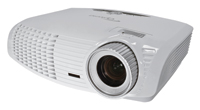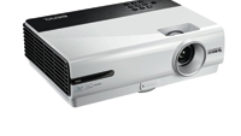

Optoma HD20 Review
Oct 7, 2009 12:00 PM,
By Jeff Sauer
A native 1080p projector that crosses the low price-point threshold and balances brightness and color.
Price erosion is hardly new to the front-projection industry and neither is the less-than-$1,000 level. We’ve seen a variety of projector classes and types—first SVGA business units, then XGA models, then 720p video projectors, etc.—hit that noteworthy sub-four-digit mark over the last few of years. Now Optoma has hit another milestone with the first native 1080p video projector: the Optoma HD20 for $999.
On the one hand, this could be seen as just another price-point threshold, but it’s certainly a big one. In the case of the HD20, it’s not just the three-digit pricing, but the fact that it sacrifices nothing in terms of resolution. Sure, home theater projectors have been this affordable in the past, but only 720p models. Right or wrong, that’s left the perception of resolution—and thus picture quality—shortcomings. The same was true of SVGA models before XGA business projectors broke the same price mark. At 1080p, consumers are getting top resolution at an affordable price.
Has Optoma found the magic formula to open the home-theater-for-the-masses floodgates? I found that the HD20 delivers a wonderful, crisp image—although there are clearly corners that have been cut to lower costs. For many, that will make for a pretty good tradeoff, including a new, broader base of home theater buyers and installers in need of affordable, yet high-quality video displays at entertainment, sports, house of worship, and other venues.
The corner-cutting starts with connectivity, although the HD20 will have all that most users need and not much extra. Specifically, there are two HDMI inputs and a signal analog 3x RCA component video set, allowing for multiple source cabling connections at one time. Optoma does include a 15-pin D-sub, doubling as VGA and a second component input, and a rather superfluous composite video input. However, there’s no S-Video input. That may be a drawback for consumers with older equipment (or familiarity with S-Video cabling), but most will prefer the extra pennies of savings.
There is no audio whatsoever; the expectation being that users will have a separate audio system. A few companies, including Optoma, have offered home-theater-in-a-box style products that have had audio, loudspeakers, and DVD players built into the projector chassis. That easy-to-use class of products never attained great success. The HD20 offers higher quality, although it assumes a higher level of media and cabling sophistication. Hopefully that will appeal to a generation that is becoming accustomed to larger images and bigger sound.
Manual focus and zoom are a given at this price point, although Optoma’s manual control knobs are obvious and easy to use. The unit can be placed on a table top or ceiling mounted with an optional mounting bracket. The menus are smartly straightforward for typical consumers and deep enough to allow installers to configure the projector to a specific environment. It even has a 12V trigger.
Optoma has included four image mode presets—cinema, bright, photo, reference, as well as a user mode—and basic color temperature settings. But if you dig a little deeper, you’ll be able to adjust individual color gain and bias, as well as gamma curves and offset. There are even controls for overscan and edge masking, and a super-wide mode for cinema aspect ratios.
Optoma HD20 Review
Oct 7, 2009 12:00 PM,
By Jeff Sauer
A native 1080p projector that crosses the low price-point threshold and balances brightness and color.
Pretty Picture, Rounded Corners
Optoma deserves a big tip of the hat for the image quality performance that the HD20 achieves. I’d say “for the money,” but that undersells quality that I’d really put at two to three times the price, or more than that if you go back just a couple of years. Naturally, part of what makes the HD20 so good is the amazing improvement in the baseline performance of today’s technology, but Optoma has made some good choices as well and the result is a very pleasant image.
For example, I can quibble a little with blues that lean toward green and greens that are a little oversaturated, but Optoma has found a nice balance between brightness and the blended colors that are more prevalent in typical video content. Skin tones are really quite good, as is the balance between black levels and grayscales. Sure, that grayscale range could be a little wider and blacks could be a little deeper, but you’ll find products for a lot more that don’t do as good a job displaying the lower range of grays and shadow details.
So where does Optoma save costs? First, image processing is more modest than you’ll find on more premium units. That means little if the source material is high quality, 1080p or 720p, and the projector isn’t being asked to do much beyond displaying the image. If your primary sources will be Blu-ray players, HD set-top boxes, and good quality or up-sampling DVD players, then the HD20 is going to be a wonderfully affordable solution. However, if the sources are more modest standard definition—particular lower quality composite input—then more problems with jaggies and posterizing appear. I found that the HD20 did do a reasonable job with de-interlacing.
Related Links

Technology Showcase: Home Theater Projectors
If you want to get the big picture, nothing beats a projector. Home theater projection systems are proving to be one of the most innovative market segments of the domestic entertainment business….

Building a Home Theater, Part 6
The theater is finished. …

Technology Showcase: Corporate Projectors
The projectors being used in corporations today reflect the realities facing our society. They are being squeezed by cost-conscious purchasers, improved by vibrant competition, wrestling with requirements meant to keep our environment clean, and generally improving in quality every year…
Second, I’m not sure where Optoma’s specifications come from, but it is not reality. I measured nothing close to the 1700 lumens claimed and less than half of that when using the Cinema, Photo, and Reference presets. Even using the Bright mode preset, I was able to measure barely more than 1000 ANSI lumens (1087 lumens). Brightness uniformity is down around 70 percent, and while widescreen projectors always have a more difficult time, this is below average.
Third, the most overt shortcoming of the HD20, particularly for anyone in the business, is an inordinate amount of light leakage from the front and left side of the chassis. I suspect Optoma has allowed this in order to reduce cooling costs (it is a DLP projector and does get hot), but it’s more leakage than I’ve seen from a projector in years and it dramatically affects the ambient room light.
Overall, the fine image quality should outweigh the negatives for most situations and users, particularly where the negatives are fairly specific. For installers, the light leakage will be a minor distraction if it’s in a public area. Otherwise, it might be masked with smart positioning. The same should be true for when quality source material and proper connections are the norm.
There’s a new price/performance champion out there among video projectors and it’s the Optoma HD20. Enjoy the show.
PRODUCT SUMMARY
- Company: Optoma
www.optomausa.com - Product: HD20
- Pros: Price, resolution, excellent price/performance, image quality.
- Cons: Light leakage, poor uniformity, modest image processing of lower quality sources.
- Applications: Home theater and venues in need of an affordable, high-quality display.
- Price: $999
SPECIFICATIONS
- Weight: 6.4lbs.
- Resolution: 1080p (1920×1080)
- Brightness: 1700 ANSI lumens
- Contrast: 4000:1 full on/off
- Native resolution: 1080p (1920×1080)
- Configuration: 1x 0.65” DMD
- Light source: 230W P-VIP lamp (rated 4000 hours, 2200 low mode)
- Lens: 1.2X manual focus F=2.55-2.87, f=22.4-26.8mm
- Zoom: 1.2x manual optical zoom
- Projection distance: 4.9’-32.8’
- Screen size: 37.6 – 301.1 diagonal inches
- Keystone: Vertical ± 5°
- Loudspeakers: N/A
- Dimensions (HxWxD): 3.8”x12.8”x9.2”
- Warranty: One year parts and labor (90 days lamp)










